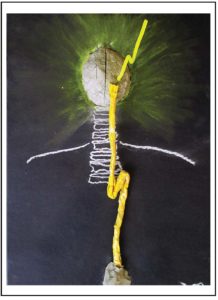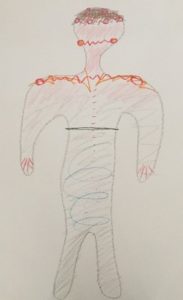
Pain Alarm
Recently I was invited to LifeCare Applecross Physiotherapy to talk about using art therapy to treat chronic pain. Learning to understand, cope and manage physical pain drew many parallels to emotional pain. As I discovered, the way we explain our pain affects how we experience it. I happily pay my money for massages despite a few challenging ouch moments, yet I would react with shock and concern if a stranger unexpectedly poked me in the shoulder.
We can think of pain signals as helpful warning signs telling us not to push our bodies to breaking point. But what if the alarm system is broken? Maybe the problem has been fixed, but the alarm is still on, telling us to take care. Or the alarm is stuck and it shouldn’t be on at all. Having a false alarm ringing in your ears all day and night is one way to imagine chronic pain.
Drawing a picture of pain in my body has been helpful to describe to other people what I am feeling. A jagged red and orange line across my shoulders and neck tells the massage therapist what to focus on. Reflecting on where the tension line came from helps me figure out what I can do to solve the root problem, as I am empowered to take the pressure off.
What is Chronic Pain?
When we experience physical pain we hope it will go away after receiving medical treatment or the injury heals. Usually it does, but for some people the pain continues despite no longer having a physical source. One in three Australians live with chronic pain, often also experiencing depression, anxiety or anger, and coping with loss and hardship associated with reduced capacity.
Everyone’s experience of pain is different, the complex interplay between the nervous system and individual factors mean that managing chronic pain is tailored to the needs of each person.
Art Therapy for Chronic Pain
Effective treatments for chronic pain include psychological approaches, which have been adapted to use art materials. Art therapy is being used to treat the psychological aspects of chronic pain and alleviate physical symptoms (Angheluta & Lee, 2011). Typical activities include mindfulness based art therapy, artistic expressions of the pain experience, exploring underlying pain themes identified in art, and reflecting on how to move forward (O’Neill & Moss, 2015).

Three-Dimensional Symbol to Represent Pain (O’Neill & Moss, 2015)
How Does Art Therapy Help?
Diversion and Relaxation
Arts and art therapy, particularly when combined with mindfulness can be a relaxing experience, remove the focus from pain and teach techniques for temporary relief.
Holistic Care
Holistic approaches broaden the focus of treatment from the physical source of pain to the impacts on the whole person. People with chronic pain may experience depression, anxiety and anger or be coping with feelings of loss, identity change and hardship as a result of reduced capacity. Art therapy can serve as an outlet for emotions or a way to process changes that affect daily life or future opportunities.
Coping and Self-Management
Beyond giving pain a rating out of ten, people with chronic pain can communicate their experience of pain through art, to feel understood and help direct treatment to where it is needed. By visually exploring pain experience in relation to life events, it’s possible to start to see patterns in what triggers the pain and what actions help with coping. Art is a creative medium where you get to choose what to change in the picture, an empowering approach that builds a sense of self-confidence in managing pain.
Trauma
Physical pain can be connected to unresolved psychological trauma which can be explored and processed in art therapy.

Body Scan Art Response: Symbolising Tension (Orange) and Pain (Red)
Limitations
Artistic ability is not needed to do art therapy, but you need to be open to trying creative expression activities. Art therapy can also bring issues to the surface so you need to feel ready and supported to work through what comes up.
The sensory qualities (odours, feel) of some materials can be overwhelming (e.g. migraine sensitivity) so material choice is tailored to the preferences of each person.
Creative Catalyst Art Therapy
Contact or book a call if you would like to discuss whether art therapy for chronic pain is right for you or your clients.
References
Angheluta, A., & Lee, B. (2011). Art therapy for chronic pain: Applications and future directions. Canadian Journal of Counselling and Psychotherapy / Revue canadienne de counseling et de psychothérapie, 45(2). Retrieved from http://cjc-rcc.ucalgary.ca/cjc/index.php/rcc/article/view/948
Chronic Pain Australia (2017). Chronic Pain Australia. Chronicpainaustralia.org.au.
O’Neill, A. & Moss, H. (2015). A community art therapy group for adults with chronic pain. Art Therapy, 32(4), 158-167. http://dx.doi.org/10.1080/07421656.2015.1091642
I check out blog sites like this a lot. As a long time sufferer of
chronic back pain from a motorcyle collission I have a lot of free
time. LOL. However, I’ve never been obliged to publish a comment, until now.
Fantastic article. I enjoyed reading it. I have actually
bookmarked your website and shared this post on my Facebook
wall.
Thanks once again for your quality work!